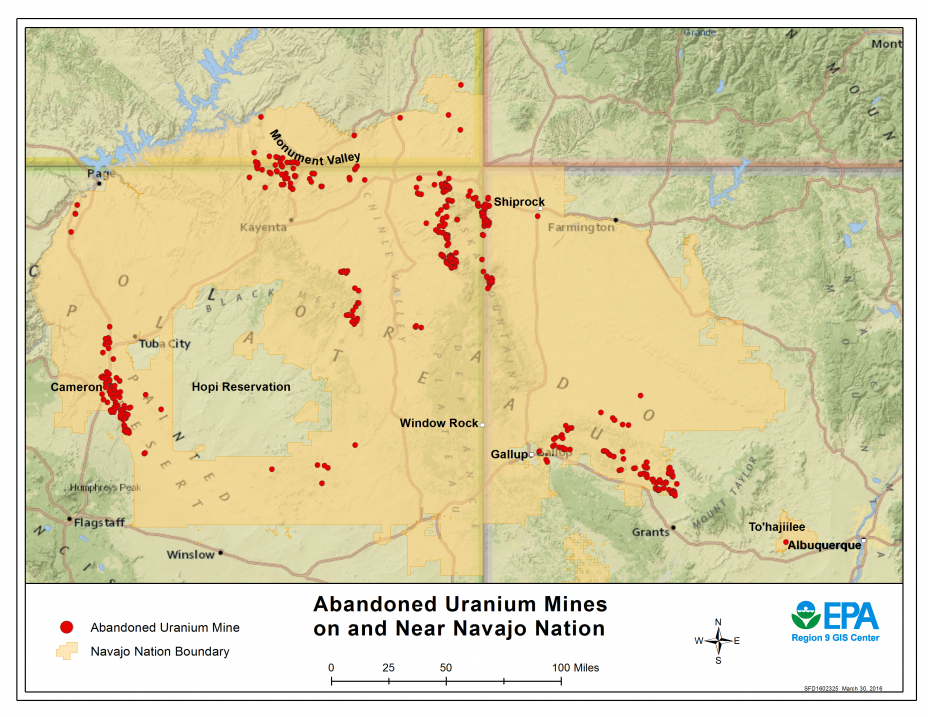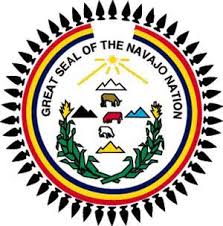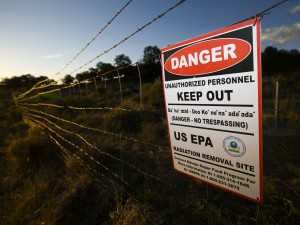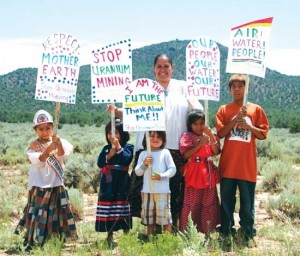When most people think of the Cold War they think of the conflict between the U.S and Russia and how a generation grew up in fear of nuclear war. However, the Cold War also significantly affected another group of people: The Navajo Nation. The Navajo suffered the negative impacts of uranium mining that was necessary to create nuclear bombs. The legacy of uranium mining on Navajo lands is a legacy of mistrust, exploitation, disease, and waste.
Starting in 1948, at the beginning of the cold war, the Atomic Energy Commission (AEC) said it would buy all uranium for a guaranteed price, which set off a uranium mining boom in the Southwest. Mines were operated by private companies, but sold only to the US government until 1971[1]. The negative environmental and health effects of uranium mining in the Southwest landed heavily on the Navajo people. Currently there are 521 abandoned uranium mines on Navajo land, one for every 52 square miles of the reservation[5]. In Environment and Society, Robbins, Hintz and Moore write that the Navajo reservation “offered up an opportunity for a high rate of labor exploitation and negligent environmental practices, an avenue that many capitalists (and bureaucrats) were content to travel”[7] .

The United States government violated the Navajo Nation’s tribal sovereignty by supporting private uranium mines on Navajo lands. This is argument is supported by two main points: 1) Navajo people were not given adequate education on the dangers of uranium mining in order to make informed decisions, and 2) the history of disenfranchisement of native peoples by the U.S. government made the Navajo vulnerable to economic exploitation.
 Native tribes are defined by the Supreme Court as “dependent sovereigns” because “their sovereignty predates that of the United States, but that it is nonetheless internal to, and dependent upon, the federal government[3]“. Sarah Krakoff defines environmental justice for tribes as “the achievement of tribal authority to control and improve the reservation environment,” making a respect for tribal sovereignty central to tribal EJ issues.
Native tribes are defined by the Supreme Court as “dependent sovereigns” because “their sovereignty predates that of the United States, but that it is nonetheless internal to, and dependent upon, the federal government[3]“. Sarah Krakoff defines environmental justice for tribes as “the achievement of tribal authority to control and improve the reservation environment,” making a respect for tribal sovereignty central to tribal EJ issues.
The Navajo Nation did have a role in choosing to have uranium mining on their land but were given little to no information on its health and environmental risks. This took away the tribes ability to make an informed choice. By the 1930s there was scientific evidence of a correlation between uranium exposure and high rates of lung cancer[1]. At the beginning of the mining boom, many Navajo workers did not speak English and lacked formal education, and there was little effort by mining companies to help educate workers across these boundaries. For example, after a 1950 Public Heath Service study on uranium, English pamphlets were given out to some miners on health risks without any translations or further explanation[1]. The U.S. government and private mining companies withheld information from Navajo miners and tribal leaders, which violated their ability to make independent decisions based on all available resources.
The Navajo people are vulnerable to economic exploitation because, since the lands they once used for subsistence living were taken away by the U.S., they are forced to depend on wage labor. Tribal councils can approve or deny mining leases, but mining is often one
of the only economic growth opportunities for tribes. In this way Navajo governments are basically forced into mining as a short-term solution for economic survival, which leads to disastrous long term health and economic impacts.
The U.S. government passed the Radiation Exposure Compensation Act (RECA) in 1991 which uses the distributive justice method to give former uranium miners compensation. RECA falls short in real justice because it only addresses a small part of the problem. RECA applies only to miners who worked before 1971 and doesn’t apply to non-miners in the affected community. Non-miners in Navajo communities continue to suffer from uranium exposure due to abandoned mines and water contamination. It is also hard to compensate people with money for things that are difficult to quantify, like losing a family member. The social justice framework outlined by Gary Bryner in Justice and Natural Resources should be used because it aims to tackle the root of injustices, look at power dynamics and take into account cultural losses[2]. It asserts that every single Navajo citizen has the right to clean water, affordable and adequate healthcare and safe working conditions. Using this framework, the U.S. government’s approach could address all the impacts of uranium mining and treat it as current, pressing injustice to the Navajo people.
The Navajo are fighting back against the uranium industry. In 2005, the Navajo Nation banned uranium mining on their land in the Dine Natural Resources Protection Act[4]. The  act was passed in response to a push by the Bush administration to increase the use of nuclear power as a clean energy source. In 2013, the Navajo Nation Council voted to block Uranium Resources Inc. from building new mining projects on the reservation[6]. Now that the Navajo Nation has information on and experience with the health and environmental harms of uranium mining, they are rejecting it from their lands.
act was passed in response to a push by the Bush administration to increase the use of nuclear power as a clean energy source. In 2013, the Navajo Nation Council voted to block Uranium Resources Inc. from building new mining projects on the reservation[6]. Now that the Navajo Nation has information on and experience with the health and environmental harms of uranium mining, they are rejecting it from their lands.
It is clear that the U.S. government and private mining companies exploited the Navajo people and violated their tribal sovereignty by failing to educate the Navajo on the risks of uranium mining and taking advantage of their vulnerable economic situation. Robbins, Hintz and Moore sum it up, writing: “The Navajo uranium era, as such, represents a classic and tragic case of environmental injustice – where unhealthful or dangerous conditions are disproportionately proximate to minority communities[7].”
Sources and Further Readings:
- Brugge, Doug and Rob Golbe. “The History of Uranium Mining and the Navajo People.” American Journal of Public Health, vol. 92, no. 9, 2002, pp. 1410-1419.
- Bryner, Gary C. “Assessing Claims of Environmental Justice: Conceptual Frameworks.” Justice and Natural Resources, edited by Mutz, Kathryn M., Gary C. Bryner and Douglas S. Kenney, Island Press, 2002, pp. 31-55.
- Krakoff, Sarah. “Tribal Sovereignty and Environmental Justice.” Justice and Natural Resources, edited by Mutz, Kathryn M., Gary C. Bryner and Douglas S. Kenney, Island Press, 2002, pp. 161- 183.
- LaDuke, Winona. “Navajos ban uranium mining.” Earth Island Journal, 2005.
- Loomis, Brandon. “Abandoned uranium mines continue to haunt Navajos on reservation.” The Arizona Republic.
- Minard, Anne. “Navajo Nation Slams Door on Deal That Would Have Allowed Uranium Mining.” Indian Country Today Media Network. August 1, 2014.
- Robbins, Paul, John Hintz and Sarah A. Moor. Environment and Society: A Critical Introduction, John Wiley & Sons, 2014.
Additional Video Resources:
- Water Contamination: https://www.youtube.com/watch?v=qjMLyISKoT0
- Democracy Now! on Uranium Mining and the Navajo:
Photo Credit Links:
- https://www.epa.gov/navajo-nation-uranium-cleanup
- http://www.npr.org/sections/health-shots/2016/04/10/473547227/for-the-navajo-nation-uranium-minings-deadly-legacy-lingers
- http://www.discovernavajo.com/navajo-culture-and-history.aspx
- http://www.azcentral.com/story/news/arizona/investigations/2014/08/04/uranium-mining-navajos-devastating-health-effects/13591333/
- http://www.whitewolfpack.com/2012/10/after-decades-of-uranium-mining-navajo.html
